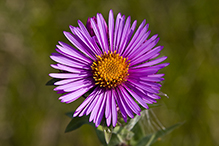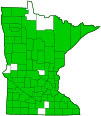New England aster
(Symphyotrichum novae-angliae)
Conservation • Wetland • Description • Habitat • Ecology • Use • Distribution • Taxonomy
Description |
New England aster is 12″ to 48″ tall, erect, perennial forb that rises on 1 to 5 or more clustered stems from a stout caudex with a few short, stout, fleshy rhizomes and occasionally slender, creeping rhizomes. The stems are stout, stiffly erect, usually with several ascending to spreading branches above the middle. They are green at first, sometimes purplish near the top, becoming light to dark brown. They are covered with short, stiff, spreading, white hairs, sparsely to moderately below, moderately to densely above. The upper stem also has short, glandular hairs that can be seen with a hand lens. The leaves are thin and often stiff. Basal leaves are usually spatula-shaped, sometimes inversely lance-shaped, ¾″ to 2⅜″ long, and 3 ⁄16″ to ⅝″ wide. They are stalkless, taper to a point at the tip, and taper at the base to the stem. The upper surface is stiffly hairy, the lower surface is softly hairy. There are 3 main veins, the two lateral veins visible on the underside. The margins have sparse, shallow teeth and a fringe of hairs. Basal leaves are usually absent at flowering. Lower stem leaves are oblong or lance-shaped, 2″ to 4″ long, and 3 ⁄16″ to ⅝″ wide. They are stalkless, taper to a point at the tip, and clasp the stem with ear-like lobes at the base. The upper surface is thinly hairy with straight, stiff, appressed hairs. The lower surface has minute or short stiff hairs. The margins are either untoothed or have sparse, shallow teeth and a fringe of hairs. Lower stem leaves are usually absent at flowering. Middle and upper stem leaves are numerous, inversely lance-shaped, 1¼″ to 3⅛″ long, and 3 ⁄16″ to ⅝″ wide, becoming gradually smaller as they ascend the stem. They are stalkless, taper to a point at the tip, and clasp the stem with ear-like lobes at the base. The upper and lower surfaces are moderately to densely covered with soft hairs. Middle and upper stem leaves are present at flowering. The margins are untoothed and have a fringe of hairs. The inflorescence is either a leafy, often crowded, pyramidal inflorescence with a main stem and branches (panicle), or a solitary head or small cluster of heads at the ends of the branches. The stalks of the flower heads are densely covered with glandular hairs. The flower heads are ¾″ to 1¾″ in diameter. The bracts at the base of the flower head (involucre) are arranged in 3 to 6 overlapping series. They are mostly linear and are tapered to a long, sharply pointed tip. The inner series is usually tinged purple. The outer series is spreading or bent backward and is covered with glandular hairs. There are 40 to 100 pink, reddish purple, or purple ray florets arranged in 2 or 3 series, and 50 to 110 orangish-yellow to reddish disk florets. The disk florets have 5 translucent stamens with yellow anthers. The fruit is a hairy achene with a tuft (pappus) of pale orangish-brown to light tan, occasionally purplish-tinged hairs attached. |
Height |
12″ to 48″ |
Flower Color |
Pink, reddish purple, or purple ray florets, yellow or orange-yellow disk florets |
Similar Species |
New England aster has larger flowers with more numerous rays than any other aster. The rays are dark purple, not pale. |
Habitat |
Wet prairie, ditches. |
Ecology |
Flowering |
August to September |
Pests and Diseases |
|
Use |
|
Distribution |
||
|
Sources |
|
| 10/10/2024 | ||
Nativity |
||
Native |
||
Occurrence |
||
Common |
||
Taxonomy |
|
Kingdom |
|
Division |
Tracheophyta (Vascular Plants) |
Subdivision |
Spermatophytina (Seed Plants) |
Class |
|
Order |
Asterales (Sunflowers, Bellflowers, Fanflowers, and Allies) |
Family |
Asteraceae (Sunflowers, Daisies, Asters, and Allies) |
Subfamily |
Asteroideae |
Supertribe |
Asterodae |
Tribe |
Astereae (asters and allies) |
Subtribe |
Symphyotrichinae |
Genus |
Symphyotrichum (American asters) |
Subgenus |
Virgulus |
Section |
Polyliguli (New England asters) |
This and other asters were formerly place in the genus Aster. That genus was problematic, in that it did not include just one common ancestor with all of its lineal descendants and no others – it was not monophyletic. In 1994, the genus Symphyotrichum was resurrected to include most North American asters formerly in the genus Aster. |
|
Subordinate Taxa |
|
|
|
Synonyms |
|
Aster altissimus Aster amplexicaulis Aster concinnus Aster muehlenbergii Aster novae-angliae Aster novae-angliae var. monocephalus Aster novae-angliae var. novae-angliae Aster novae-angliae var. roseus Aster repertus Aster roseus Aster spurius Aster spurius var. novae-angliae Aster spurius var. spurius Diplactis novae-angliae Diplactis novanglia Lasallea novae-angliae Virgulus novae-angliae |
|
Common Names |
|
hairy Michaelmas daisy Michaelmas daisy New England aster |
|
Glossary
Caudex
A short, thickened, woody, persistent enlargement of the stem, at or below ground level, used for water storage.
Clasping
Describing a leaf that wholly or partly surrounds the stem but does not fuse at the base.
Glandular hairs
Hairs spread over aerial vegetation that secrete essential oils. The oils act to protect against herbivores and pathogens or, when on a flower part, attract pollinators. The hairs have a sticky or oily feel.
Involucre
A whorl of bracts beneath or surrounding a flower, flower head, or flower cluster.
Linear
Long, straight, and narrow, with more or less parallel sides, like a blade of grass.
Panicle
A pyramidal inflorescence with a main stem and branches. Flowers on the lower, longer branches mature earlier than those on the shorter, upper ones.
Pappus
The modified calyx composed of awns, scales, bristles, or feather-like hairs in plants of the Aster family such as thistles and dandelions.
Rhizome
A horizontal, usually underground stem. It serves as a reproductive structure, producing roots below and shoots above at the nodes.
Visitor Photos |
||
Share your photo of this plant. |
||
This button not working for you? |
||
Greg Watson |
 |
Norwegian Ridge Birding and Nature Trails. |
Kirk Neslon |
||
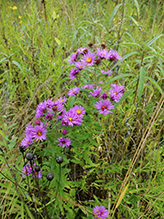 |
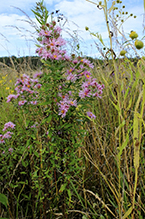 |
|
Pink Flowers |
||
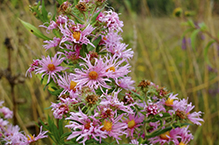 |
|
|
Robert Briggs |
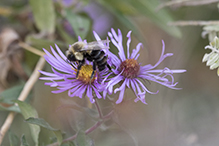 |
New England Aster (Symphyotrichum novae-angliae) visited by late season pollinator - Bumble bee - October 29th in Spring Lake Park Reserve. |
MinnesotaSeasons.com Photos |
||
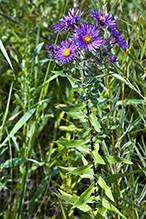 |
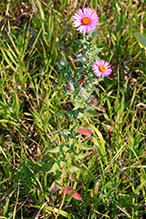 |
|
Plant |
Plant |
|
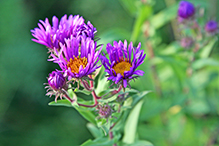 |
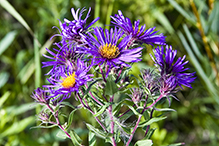 |
|
Inflorescence |
Inflorescence |
|
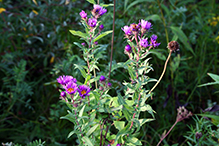 |
||
Inflorescence |
||
|
||
|
||
|
Flower head |
|

|
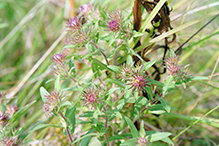 |
|
Buds |
||
|
||
|
||
Buds |
|
|
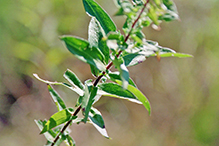 |
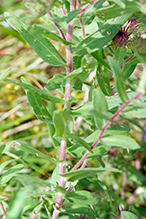
|
|
Leaves |
||
|
||
|
||
|
Stem |
|

Slideshows |
Symphyotrichum novae-angliae |
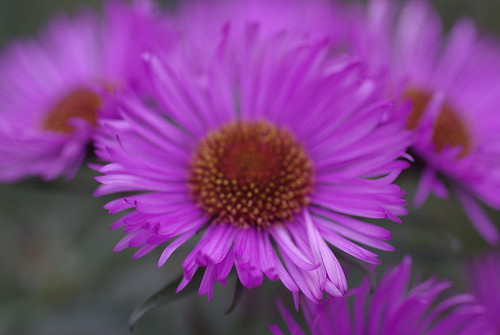
|
About
New England Aster, aster, luktaster |
New England Asters |

|
About
These bloom very late in the summer here. They have red, woody, fuzzy stems. |
Symphyotrichum novae-angliae (New England Aster) |
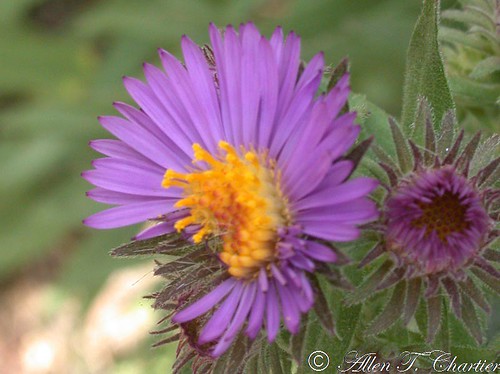
|
Aster novae-angliae NEW ENGLAND ASTER |
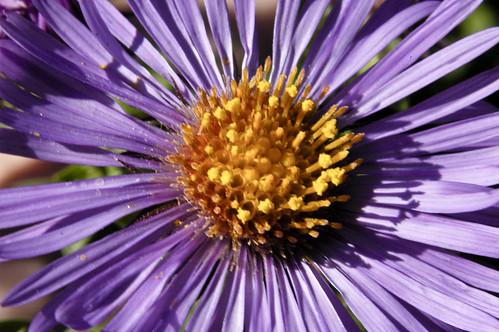
|

Visitor Videos |
||
Share your video of this plant. |
||
This button not working for you? |
||
|
Other Videos |
||
MyNature Apps; Identifying New England Aster, Symphyotrichum novae-angliae |
About
Uploaded on Aug 6, 2011 How to identify New England Aster, Symphyotrichum novae-angliae. www.mynatureapps.com |
Minnesota Native Plant - New England Aster (Aster Novae-Angliae) |
About
Published on Sep 14, 2013 A great fall plant for the native garden is the New England Aster (Aster Novae-Angliae). |
New England Aster, Symphyotrichum novae-angliae |
About
Uploaded on Oct 7, 2010 This is easily one of the prettiest "Asters" native to North America in my opinion. This plant comes in a variety of colors too, not just the purple seen here, but also red, pink, and varying intensity or paleness as well. Often times when this plant is sold in stores they are cut down to just a few inches in June or July. This helps promote a dome-like habit with their dense clusters of flowers. They otherwise grow tall and can fall over, as seen in the video, if not supported. Asters shouldn't be confused with Chrysanthemums which are native to Asia. |
Michaelmas Daisy - Fjallastjarna - Blástjörnufífill - Sumarblóm |
About
Published on Oct 9, 2013 Aster can be perennials, annuals or subshrubs, mostly with narrow leaves, and solitary or clustered, daisy-like flowers, usually in late summer and autumn. : http://apps.rhs.org.uk/plantselector/plant?plantid=193 Symphyotrichum novae-angliae commonly known as the New England Aster or Michaelmas Daisy, is a flowering herbaceous perennial plant in the Asteraceae family. It is native to almost every area in North America east of the Rocky Mountains, but excluding the far north of Canada as well as some of the southern United States. Symphyotrichum novae-angliae was introduced to Europe in 1710; a common garden escape, it has naturalized along roadsides and on disturbed ground. : http://en.wikipedia.org/wiki/Symphyotrichum_novae-angliae Fróðleikur um afskorin blóm og meðferð þeirra : http://www.bondi.is/lisalib/getfile.aspx?itemid=1729 Aster alpinus 'Goliat' - Fjallastjarna - Blástjörnufífill Blá blóm: https://sites.google.com/site/gardafloraperennials/perennials/perennials-a-b/aster-alpinus-goliat Filmed with Panasonic Lumix DMC- TZ20 camera. David Rudwick - Gardens and Greenhouse at work - West Lavington. horticulture |

Visitor Sightings |
||
Report a sighting of this plant. |
||
This button not working for you? |
||
| Greg Watson 9/24/2024 |
Location: Norwegian Ridge Birding and Nature Trails New England Asters were also blooming in the prairie. |
 |
| Kirk Nelson 9/360/2017 |
Location: Whitetail Woods Regional Park |
 |
| Robert Briggs 10/29/2016 |
Location: Spring Lake Park Reserve New England Aster (Symphyotrichum novae-angliae) visited by late season pollinator - Bumble bee - October 29th in Spring Lake Park Reserve. |
 |
MinnesotaSeasons.com Sightings |
||
Carver Highlands WMA, South Unit Cedar Creek Ecosystem Science Reserve Margherita Preserve-Audubon Prairie Mound Spring Prairie SNA, North Unit Pembina Trail Preserve SNA, Crookston Prairie Unit Richard M. & Mathilde Rice Elliott SNA Sand Prairie Wildlife Management and Environmental Education Area |

|
Created: Last Updated: © MinnesotaSeasons.com. All rights reserved. |
